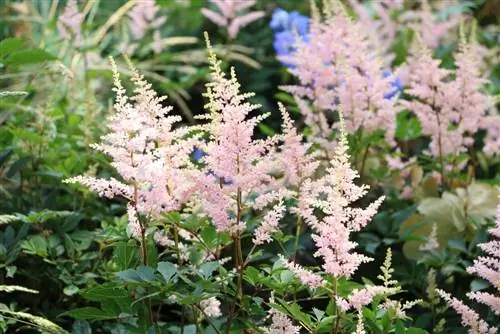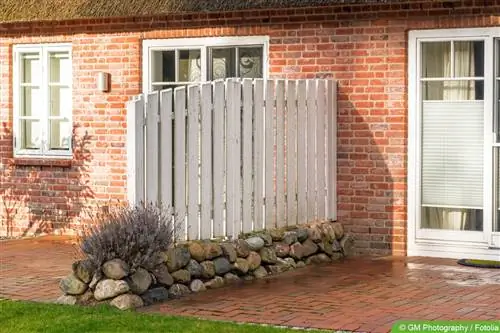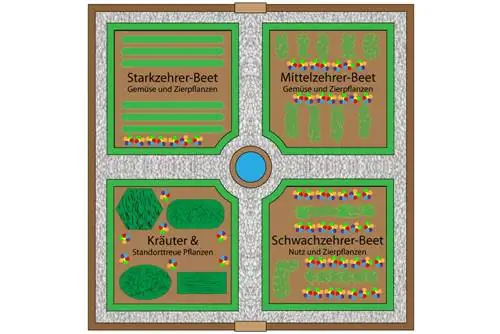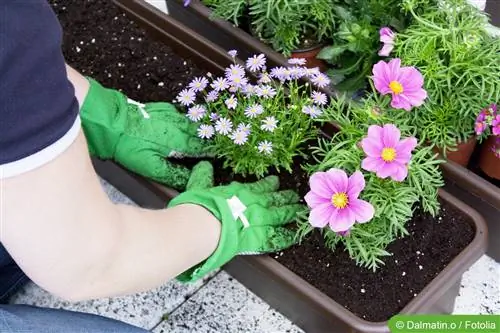- Author admin [email protected].
- Public 2023-12-17 03:39.
- Last modified 2025-01-24 12:45.
For people from the city, a green oasis can usually only be achieved with a balcony. In order to still create your own little oasis of well-being, the plants should be selected based on the location of the balcony. For example, bluebells do not feel very comfortable in the blazing sun of a south-facing balcony. On the other hand, the lantana does not bloom nearly as well in a shady location as in a sunny spot. With the right balcony plants and matching furniture, the balcony becomes an extended living room.
Plants for the shady north balcony
During the day, a north-facing balcony hardly sees any sun. For this reason, they are usually quite modestly equipped with plants. Admittedly, when planting on the balcony you have to avoid roses, geraniums or citrus trees. However, there are also enough partial shade and shade plants that can be used to transform a north-facing balcony into a sea of flowers. Ferns, some grasses and small trees such as cherry laurel or dwarf spruce are particularly suitable as balcony plants. If you want to add more splashes of color, choose:
- Fuchsias
- Magnificent Sparrows
- Globe primroses
- Hardworking Lieschen
- Bluebells
bleeding heart
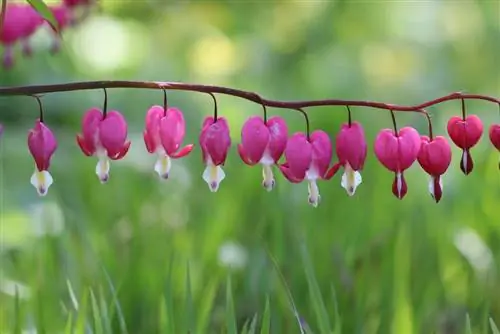
Just like the rhododendron, the hydrangea also prefers a partially shaded spot. However, the different varieties have different demands on the location. Advice on balcony planting would be recommended at the garden center. Another highlight can be set with ivy and boxwood. Ivy is pretty undemanding and enhances every corner on the balcony, no matter how ugly. Snowflake flowers feel at home in the north. They grow together as hanging plants to form a veritable sea. The slipper flower, with its bright yellow hue, also thrives in the shade.
Sun-hungry plants for the south-facing balcony
A south-facing balcony is a dream for sun-hungry plants. For balcony planting, the trend is for plants that grow as a trio. They offer variety and impress with their variety of colors. Such combinations are, for example, verbena, snow princess and magic snow or magic bells, verbena and elf flowers. Other sunbathers are:
- Dahlias
- lantana
- Strawflower
- Farmer Orchid
- Sun Fairy
- Lavender
- some houseleek species
- Petunias
- Geraniums
- small-growing roses
- Hussar head
- Bougainvillea
In addition, ornamental tobacco, vanilla flower, moon glories and levkoje enjoy the sun during the day to show their full bloom in the evening hours. They are so-called night-flowering plants and attract visitors with their magical scents. Oleander is really in love with the sun and should be included in the balcony planting on the south side, just like the triplet flower. Lemon and orange trees as well as ornamental bananas are sun worshipers and won't sweat on the south-facing balcony.
If you want to conjure up a Mediterranean flair on your balcony, use rosemary, sage, mint or thyme in terracotta pots. Tomatoes, peppers or strawberry bushes can also be cultivated on a south-facing balcony.
Summer flowers for the east and west balconies
A south-facing balcony is great. An east or west facing balcony is no less good. Although they are only kissed by the sun for a few hours a day, you can also plant a lot of flowers, grasses and trees here. The choice of plants depends on how high the light is, whether there are trees in front of it or whether there is a shadow in front of the balcony. All of these are crucial criteria for selecting the right plants. As a rule, the following are suitable for balcony planting:
- Dahlias
- Hardworking Lieschen
- Nasturtium
- African Lily
- Ivy
- Fuchsias
- Chrysanthemums or
- Begonias
- Boxwood
- Storksbill
Small hostas and ivy are ideal as structural plants. Ivy, as a climbing balcony plant, can protect you from many prying eyes. Purple bells, spurge and the silver-leaved forget-me-not are hardy perennials and impress with their great coloring.
Männertreu scores with its rich blue flowers. With its fiery colors and bright flowers, the marigold creates very special color accents on an east or west balcony when planted on a balcony. Depending on the variety, hydrangeas and rhododendrons also deserve a partially shaded place. The advantage of these plants is that they only need to be repotted into a larger container with fresh soil every two years.
Especially on an east-facing balcony, in addition to spring flowers such as daffodils, tulips or crocuses, evergreen dwarf trees can also be planted, as the sun only falls on the balcony in the morning hours. Impatiens or lobelias are also perfect. If you have a west-facing balcony, put your feet up, enjoy the sunset and enjoy the beguiling scents of angel trumpet, miracle flower, ornamental tobacco or evening primrose.
General Tips
Lush planting in balcony boxes and pots should be avoided if possible, otherwise the plants will have little space. A balcony box with a length of one meter offers enough space for three to five plants. The water often builds up in the boxes and buckets. A pot drain is therefore extremely important. A water level indicator that almost completely eliminates overwatering is ideal. Partially shaded and shady balcony plants require less water than their counterparts on the sunny side. Therefore, flowers, grasses and trees should be watered in the morning. If you water in the evening, you risk waterlogging, which is the ideal soil for fungi and mold.
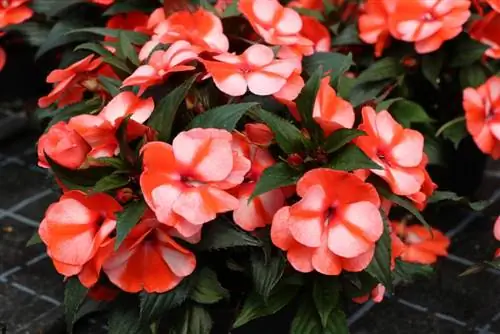
A high-quality substrate should be chosen for balcony planting. Because the demands on the earth are high. On the one hand, the substrate must be able to absorb and store nutrients and water and, on the other hand, it must remain loose. It is therefore advisable to choose branded products. When fertilizing, the instructions for each individual plant should be followed. For freshly planted protégés, fertilization can begin after a week. To ensure that the plants have enough strength to form new flowers and that seeds do not form, it is necessary to remove dead parts of the plant. This is done either with scissors or your fingers.
What you should know in brief
There are lots of beautiful plants for balconies (balcony plants), although depending on the season you should choose different balcony plants or robust plant varieties that are relatively insensitive to rain, wind and cold.
potted plants
The potted plants include yellow daisies, sun daisies, marigolds, busy lizards, geraniums, nasturtiums, chocolate cosmos, fuchsias, blue Mauritius, petunias, jasmine, sorrel, snowdrops, fire sage, miniature roses and bluebells.
Herbs
If you plant herbs yourself, you have your own natural spice shelf and you don't have to buy spices in a store every time. The best-known representatives of herbs include basil, mint, peppermint, lemon balm, thyme, chives, lavender, sage, chervil, dill, garden cress, pepper, marjoram, savory, lovage, oregano and rosemary.
climbing plants
Climbing plants such as golden vine, bellwood vine, grape vine, tree shrike, wisteria, trumpet flower, climbing cucumber, false vine, climbing spindle, hops, forest ivy, winter jasmine, fragrant vine, Japanese wisteria and wild vine also look very nice on a balcony.
Fruits & Vegetables
In addition to the plants mentioned, fruits and vegetables such as kiwi, apples, potatoes, lettuce, lettuce and raspberries can also be placed on a balcony. This gives you the guarantee that the fruits or vegetables are fresh and untreated.
Editor’s Tips
- Of course it always depends on which direction the balcony is facing. A box on the sunny south side must be planted differently than a box on the north side.
- The right plant substrate is important.
- Only plants that match their requirements should be placed in a box. A plant that needs hardly any water is not a good match for one that needs to be watered twice a day.
- Plant boxes with irrigation reservoirs are ideal. They can sometimes go two to three days without watering.
- Automatic irrigation systems are just as affordable.
- Drainage in the bottom of the box is practical so that excess water can drain away.
- To save money, you can grow your own balcony plants. The important thing is to start on time
If you don't want to replant your balcony box several times a year, you should choose a plant that can survive all seasons. The smallest species of conifers are suitable, as they are evergreen and are also good to look at in winter, a few spring-flowering bulbs in between, flowering plants for the summer and a beautiful, eye-catching leafy plant for the autumn. A nice piece of grass in between, that's all you need.

